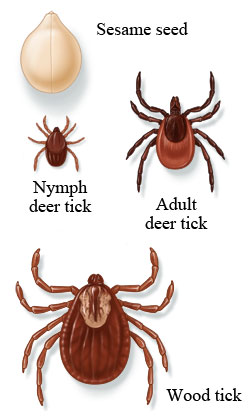Lyme Disease: Care Instructions
Overview

Lyme disease is a bacterial infection spread by ticks.
Antibiotics can treat Lyme disease. If you do not treat Lyme disease, it can lead to problems with your skin,
joints, heart, and nervous system. These problems can develop weeks, months, or even years after you get the
infection.
Your doctor may prescribe antibiotics even if it is not yet certain that you have Lyme disease.
Follow-up care is a key part of your treatment and safety. Be sure to make and go to all
appointments, and call your doctor if you are having problems. It's also a good idea to know your test results
and keep a list of the medicines you take.
How can you care for yourself at home?
-
Take your antibiotics as directed. Don't stop taking them just because you feel better. You need to take
the full course of antibiotics.
-
Ask your doctor if you can take an over-the-counter pain medicine if needed, such as acetaminophen
(Tylenol), ibuprofen (Advil, Motrin), or naproxen (Aleve). Read and follow all instructions on the label.
How can you prevent Lyme disease?
-
Avoid ticks.
-
Learn where ticks are found in your community. Stay away from those areas if possible.
-
Cover as much of your body as possible when you work or play in grassy or wooded areas. Wear a hat, a
long-sleeved shirt, and long pants with the legs tucked into your socks. And keep in mind that it's
easier to see ticks on light-colored clothes.
-
Use insect repellents, such as products containing DEET. You can spray them on your skin.
-
Use products that contain 0.5% permethrin on your clothing and outdoor gear, such as your tent. You
can also buy clothing already treated with permethrin.
-
Take steps to control ticks on your property if you live in an area where Lyme disease occurs. Clear
leaves, brush, tall grasses, woodpiles, and stone fences from around your house and the edges of your
yard or garden. This may help get rid of ticks.
-
When you come in from outdoors, check your body for ticks, including your groin, head, and underarms. The
ticks may be about the size of a poppy seed. If no one else can help you check for ticks on your scalp, comb
your hair with a fine-tooth comb.
-
If you find a tick, remove it quickly. If you can't remove it with your fingers, use tweezers to grasp the
tick as close to its mouth (the part in your skin) as possible. Slowly pull the tick straight out—do not
twist or yank—until its mouth releases from your skin. If part of the tick stays in the skin, leave it
alone. It will likely come out on its own in a few days.
-
Check your clothing, outdoor gear, and pets. Ticks can come into your house on them. The ticks can then
fall off and attach to you.
-
Check your clothing and outdoor gear. Remove any ticks you find. Then put your clothing in a clothes
dryer on high heat for about 4 minutes to kill any ticks that might remain.
-
Check your pets for ticks after they have been outdoors.
When should you call for help?
 Call your
doctor now or seek immediate medical care if:
Call your
doctor now or seek immediate medical care if:
Watch closely for changes in your health, and be sure to contact your doctor if:
Current as of: June 12, 2023
Content Version: 14.0
Care instructions adapted under license by your
healthcare professional. If you have questions about a medical condition or this instruction, always ask
your healthcare professional. Healthwise, Incorporated disclaims any warranty or liability for your use of
this information.